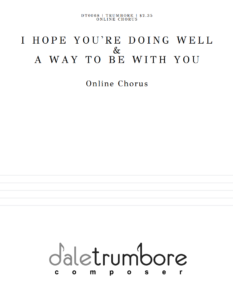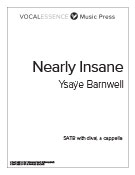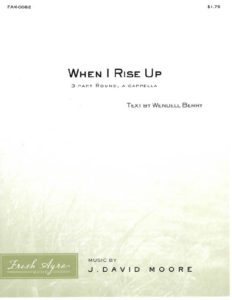Contributing Editor: Jonathan Campbell
Many of us are focusing on virtual performances and remote learning and recording. There are abundant pieces in the Graphite catalog geared for smaller ensembles. These pieces are great for those teaching from home, virtual choirs, or organizing small groups without much rehearsal time.
 “I Hope You’re Doing Well” and “A Way To Be With You“
“I Hope You’re Doing Well” and “A Way To Be With You“
Dale Trumbore recently composed a set of two partsongs for online chorus: “I Hope You’re Doing Well” and “A Way To Be With You” (flexible voicing). Trumbore meets the challenges of these times with music that is flexible, approachable, and relevant. As we continue to stay apart, Trumbore’s music provides an opportunity to be together.
“I wrote these two short pieces as an experiment,” Trumbore says, “when performances were being cancelled back in March and we were all wondering what kind of music could be made virtually. I’m so grateful to the choruses and conductors who beta-tested these pieces in their earlier drafts, which led to these revised versions that are even more accessible for live virtual performances.”
The repetitive patterns in “Nearly Insane” (SSAATB), by Ysaÿe Barnwell, make it an eminently approachable piece. Constructed with layers of varied ostinati, the piece sings itself once every voice part is learned. In addition, the rhetorical meaning of quilt patterns is cleverly expressed by this compositional technique.
As fall approaches, so do seasonal concerts and worship services. We may not know what the holidays will look like, but we do know that music will go on. Mike Weber has a lovely arrangement of the “Coventry Carol” (SAB, piano) that would work well for a small ensemble or virtual situation.
 “If You Can Walk You Can Dance”
“If You Can Walk You Can Dance”
Elizabeth Alexander’s “If You Can Walk You Can Dance” (for SATB, SAB, SSA, TTB) is similar in some ways to “Nearly Insane.” Repeating choral parts make it easy to teach and easy to sing. The positive message and joyful music is also something that might cheer some hearts.
“Jewett” (for SATB, SSA, TBB) is a simple, straight forward, and delightful arrangement of the traditional hymn by John Newton (with a different tune) in a shape-note style. Open fifths and fourths coupled with a hearty rhythm evoke a simpler time when neighbors and friends would gather together to sing. Now we can gather on our computers and find similar rewards.
One of our best sellers, “Gamaya” (round for mixed or equal voices) has found new importance in these times. The repetitive patterns continue to serve the choral community well for online learning. A “mantra for peace and truth,” “Gamaya” communicates an important message, both in content and style. It’s also a beautiful piece that audiences enjoy, online or in person.
This Youtube video features the Profectus Chamber Choir in a choreographed performance.
“Gamaya” by Paul John Rudoi, as performed by Profectus Chamber Choir in August 2019 at Madison Street Church in Riverside, CA
North Dakota State University professor Charlotte Moe arranged an easy piece by Giovanni Martini, entitled “Rejoice in Song” (SAB, piano or SSA, piano). Like some other works in this article, the use of canon makes for easy and approachable teaching. “Rejoice in Song” also provides an opportunity to teach about Martini and the late Baroque era.
For younger singers, try “Muchas Gracias” (canon for treble voices) by Jesús Echevarría. Sung in Spanish, “Muchas Gracias” can be made even more enjoyable with the addition of instruments, such as guitar, clarinet, and bass. There is no reason adults couldn’t also sing this piece, especially to gain confidence in a virtual context. Scored for unison voices in canon.
A new round from Jocelyn Hagen and Timothy C. Takach, written at the beginning of quarantine for a class of seniors who wouldn’t be able to finish out their final year of singing together. “Build the Sky” has flexibility in performance options, including an optional descant and homophonic coda.
J. David Moore’s three-part canon “When I Rise Up” (3 part round) is a wonderful way to conclude this article—it communicates the joyful, assertive, and hopeful message we all need these days. This piece gives younger singers a chance to sing with soul and then to celebrate their accomplishment with a great virtual performance.
Our Contributing Editor
Jonathan Campbell received his B.A. from Luther College in 1998, a Master of Sacred Music degree from Luther Seminary, St. Paul, Minnesota in 2002, and a Doctor of Musical Arts in choral conducting in 2015 at North Dakota State University. As a composer, Jon has received numerous awards and commissions, including a Faith Partner’s Residency through the American Composer’s Forum, as well as first place in the Morningstar College Choral Composition Festival. From 2004-2012, Jon conducted the Honors Choirs of Southeast Minnesota Chorale and in the spring of 2011, served as interim director of choral activities at Winona State University. At Augsburg University, Minneapolis, MN he recently served as faculty conductor of the Cedar Singers male chorus and the Masterworks Chorale. Jon is founder and was artistic director of the Minnesota Renaissance Choir, and is currently Director of Music and Fine Arts at Claremont United Church of Christ and Lecturer in Music at Pomona College, both in Claremont, CA.










Leave a Reply
You must be logged in to post a comment.